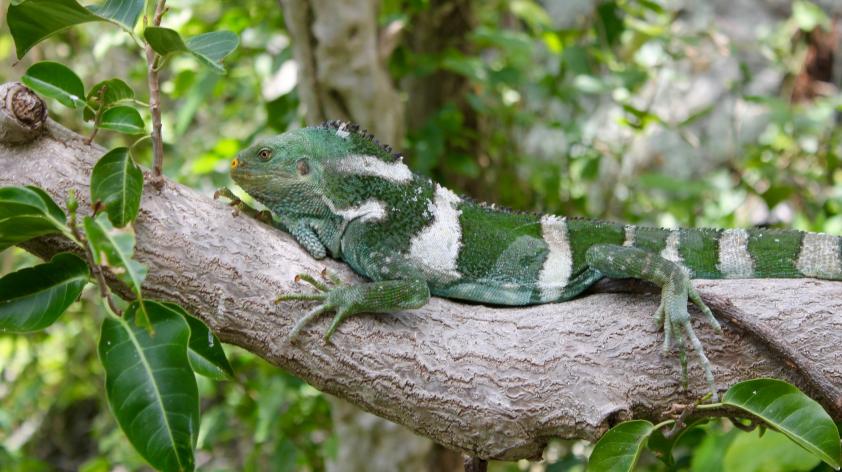
Fiji Iguana Conservation from Both Sides Now
Part One: In the Field
When I say the trail leads straight up the hill, I mean straight up. For the second night in a row, I am walking a 250-meter transect freshly hacked through the thick, humid understory on this tiny island in Fiji. Spider webs brush my face, and roughly-cut stems snag my pant leg as I haul myself up the path, trying to keep my footing in the slick mud. I bat away a horde of gnats drawn inexorably to my headlamp and crane my neck up at an awkward angle to scan the tree limbs above. I am looking for the critically endangered Fiji iguana, and I am loving it.
There are currently three species of iguana in Fiji: the Lau banded iguana (Brachylophus fasciatus), the Fiji crested iguana (B. vitiensis), and the Fiji banded iguana (B. bulabula). Fiji banded iguanas can be seen by visitors to the San Diego Zoo, where our Curator of Herpetology and Ichthyology, Kim Lovich, manages the Species Survival Plan (SSP) for the species. In the wild, our collaborators Robert Fisher (US Geological Survey) and Peter Harlow (Taronga Zoo), with support from the National Trust of Fiji, have found iguanas-- some with new color patterns and sizes-- on about half of 80 surveyed islands. To properly understand and conserve this diversity in the wild and in captivity, we use careful field studies and laboratory techniques.
As someone who works in the lab, I’ve always heard that finding and sampling Fiji iguanas is tricky work. Now I know it firsthand. As part of the Iguana Specialist Group meeting in Fiji, I am participating in a field trip to help spot and sample iguanas. At least I’d like to say I’m helping. My fellow spotters are herpetologists with the sharpest eyes and best lizard-handling skills I’ve seen. Since the arboreal iguanas’ striped green skins hide them among the leaves during the day, surveys happen at night, when a light shone on an iguana reveals its lighter underside among the foliage. I am keeping my eyes peeled, squinting up at what turns out to be just a light-colored clump of leaves, when I hear someone shout, “Iguana!” followed by cries of, “Pole! Pole!” A 30-foot telescoping pole is handed to the spotter, who uses it to gently dislodge the iguana from its branch and bring it down to ground level. If the iguana doesn’t latch on to the pole, a nimble team-member shimmies up the tree to pluck the lizard from its perch and bring it back down. It’s beautiful. This is the first time I’ve seen a Fiji iguana in the wild, and I’m transfixed. It looks back at me with no fear, as only an island-adapted species can, and promptly goes back to sleep.
The team painstakingly measures each animal, tags it for identification, and samples it for genetic analysis-- all while seated on a narrow, impossibly steep trail with headlamps surrounded by those giddily dancing gnats. They repeat this process for each iguana captured-- about 15 in all-- until we reach the end of the transect, in a clearing at the top of the island. It’s been a hard day’s night, and I’m thoroughly impressed with the team’s accomplishments.













